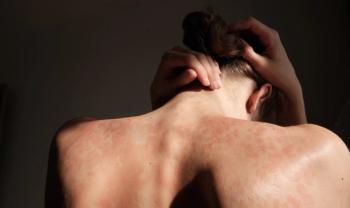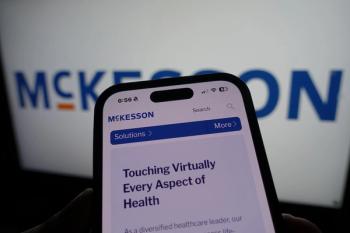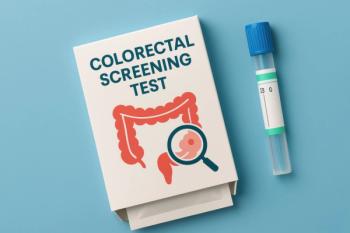
Delgocitinib Is Redefining Chronic Hand Eczema Treatment: A Q&A With Raj Chovatiya, MD, PhD, MSCI
Delgocitinib has emerged as a promising treatment for CHE, addressing unmet needs and enhancing understanding of this complex condition, notes Raj Chovatiya, MD, PhD, MSCI.
Chronic hand eczema (CHE) can be challenging for clinicians to treat because most individuals present with overlapping etiologies, including components of atopic, irritant, and allergic contact dermatitis. The disease is multifactorial, frequently driven by irritant contact dermatitis triggers, and management typically focuses on eliminating known triggers and optimizing cleansing and moisturization, explains Raj Chovatiya, MD, PhD, MSCI, associate professor at the Rosalind Franklin University of Medicine and Science Chicago Medical School, and founder and director of the Center for Medical Dermatology and Immunology Research in Chicago, Illinois.
Confidence in delgocitinib's role as a chronic treatment is bolstered by long-term data from studies like the DELTA 3 open-label extension trial (
This in-depth interview emphasizes that delgocitinib offers a highly effective treatment option that is strategically positioned for patients who have tried initial topical therapy, such as topical corticosteroids, but have not shown substantial improvement or tolerance. The
This transcript has been edited for clarity.
AJMC: Is CHE difficult to diagnose?
Chovatiya: CHE can be challenging, given that we oftentimes are really, really steadfast on finding and citing etiologies. That's a very traditional way of thinking about the disease, but as it turns out, the majority of individuals who have CHE usually have multiple overlapping etiologies. Oftentimes there's some component of
I guess the better answer to your question is: while it's sometimes challenging to maybe look for a singular cause, because there often isn't a singular cause, it's not so difficult to make the diagnosis, as the only criteria you're really looking for are CHE that occurs for at least 3 months or has 2 instances of flare over the course of a year.
AJMC: What triggers CHE?
Chovatiya: Because CHE itself is multifactorial in terms of its etiology, there can be multiple triggers driving the disease itself. Irritant contact dermatitis is one of the most common contributory etiologies. That can be triggered by the use of anything: from a lot of hand washing and wet/dry cycles, to soaps and cleansers, to other chemicals on the hands or other types of work as well. In the case of allergic contact dermatitis, less common, but that would be sort of true allergens that might be existent in personal products.
Atopic dermatitis is an important consideration. A lot of people just have baseline risk for atopic dermatitis, both intrinsic and extrinsic and so that can be a triggering factor. Then, in the case of contact urticaria or protein contact dermatitis, certain substances are known to cause urticaria, which when left chronic can also result in some of the scaling and signs we think about in disease.
There's a lot of different triggers, and they can be unique and individualized among patients with CHE. One of the main things that we usually start our treatment journey off with is trying to see if we can eliminate any known triggers, optimize moisturization, optimize cleansing, and see if that's enough without adding medication.
AJMC: What remaining unmet needs in CHE treatment does the approval of delgocitnib address?
Chovatiya: I think that number 1, our ability to really diagnose and call out this disease, especially in the US, where CHE has never really been sort of emphasized as a diagnostic category, is one big goal, and having treatment should hopefully help us understand the disease state a little better. I think number 2, what would be nice is that if we could really take the burden from our patients. A topical that is administered twice daily is awesome, but what is the right point at which if somebody is doing well, we might be able to stop treatment or extend our treatment intervals or have more intermittent treatment? Would proactive treatment, even when things are clear, be a good strategy to stave things off, given how effective delgocitinb is? I think that's another thing on my radar as well.
AJMC: Where do you see delgocitinib fitting into the current treatment paradigm of CHE?
Chovatiya: I would view delgocitinib for my patients really being right after they've tried a topical therapy. In most cases, topical corticosteroids are what we might try for someone who comes in with the signs and symptoms of CHE. They might get a go of it for several weeks and come back into the office if they're really not showing substantial improvement or they're really not tolerating the treatment well. That's somebody who going to move to delgocitinib; it's a pretty easy decision.
In terms of really thinking about some of the other elements of my workup, if I'm concerned that there potentially might be a need for some type of allergic contact patch testing, maybe some other diagnostics, culture, biopsy, swabs, scraping, etc, there's still a really nice option for us to move to delgocitinib and not have to make the patients wait around for sometimes a workup that may take a long time. Really, it's a very efficient strategy to help get patients off topical corticosteroids and get them on something highly effective.
AJMC: The DELTA 3 trial demonstrated delgocitinib's efficacy, safety, and ability to maintain disease clearance through week 52. How important are these longer-term data for establishing confidence in delgocitinib's role as a chronic treatment?
Chovatiya: The DELTA 3 study was designed to take a look at patients over the long term, after they finished their primary vehicle controlled period, and see how they did with therapy that was designed around real-world use—meaning that patients were sort of treating if they needed to, holding on to treatment if they didn't need to. Bottom line, the data suggested that by the population of treatment, a very similar proportion maintain that response and maintain their improvement in itch, pain, and other parameters throughout the course of treatment as well.
I think that this is important for any formal confidence that we need to suggest that the results that you see in the primary treatment period are not going to drop off, and you're going to see substantial improvement continued over the course of many, many weeks to months, with intermittent use of a medication like delgocitinb.
AJMC: How would you advise clinicians to balance the efficacy of delgocitinib with potential safety concerns in real-world practice, particularly regarding patient selection and ongoing monitoring?
Chovatiya: I will tell you, from the perspective of somebody who’s been involved in this space for a long time, someone who's been part of the journey of development for JAK inhibitors, this is perhaps one of the cleanest labels that we've ever seen for a medication, both in this space and for a JAKinhibitor as well. A big important point to mention is that this particular product, and it’s backed by very strong safety data, does not contain a boxed warning like any of the other JAKinhibitors, both topical and oral, that are used to treat individuals with
If you take a look at the AE table as well, you'll find there's actually very few AEs that really seem to be reported to some degree of commonality, compared with the vehicle control, which is also very reassuring. And to the point that patients may have potential site infections or potential melanoma skin cancer, there wasn't a clear relationship between the medication and any events that were observed in the studies themselves as well. If you go through the safety data, most of these things are contained—if there was really any type of event that occurred, whether or not it appears to be related to the drug itself. I think there's also some cautionary wording, too, given that this is part of the class of JAK inhibitors, that some of this stuff has been associated with the use of other JAK inhibitors for inflammatory disease as well.
I would say that this one is a pretty easy discussion, where efficacy far outweighs any of the safety risks that I'm really worried about, alongside the fact that there's no specific lab monitoring and that this is a nonsteroidal, meaning that many of the things that I would expect to see from a steroid—skin thinning, dyspigmentation, loss of subcutaneous fat, even worsening of the skin barrier—are not going to be concerns here.
AJMC: Delgocitinib's appropriateness in a pediatric population has not been investigated. What are the next crucial areas of research or clinical development you would like to see?
Chovatiya: The pediatric population is interesting. CHE is not so common in that group. It can happen but given that CHE is a conglomeration of various risks related to irritant contact dermatitis, atopic dermatitis, allergic contact dermatitis, and protein contact dermatitis, usually you're not seeing that much irritant contact and allergic contact in that group. Thus, because kids aren't doing that much work with their hands—they're not necessarily working for a living, having a lot of exposures, or even washing excessively—CHE is just a little less common. Data in a younger age group would be great, but maybe it's a little lower on my wish list of understanding some of these other parameters that I pointed out as well.
I think about other mechanisms of action that are nonsteroidal, too. We definitely need more nonsteroidal therapies across a variety of indications. We've seen a bevy of approvals over the last few years in both the non-JAK and the JAK inhibitor family for nonsteroidal topicals. It would be nice to see if some of those mechanisms of action and others out there also might potentially be helpful for patients with CHE.
It's an exciting time for us in dermatology in general, just given how much is happening in our systemic and topical treatment space, especially because things felt so stagnant for so long in multiple disease states. In the case of topical delgocitinib, it's particularly exciting given that CHE is oftentimes one of the banes of our existence in clinical dermatology just because it's so hard to address and treat, given how multifactorial its etiology is, as well as morphology. It's amazing to see that we have a treatment like delgocitinib that should hopefully help a lot of patients who otherwise do not have good options.
Newsletter
Stay ahead of policy, cost, and value—subscribe to AJMC for expert insights at the intersection of clinical care and health economics.













































